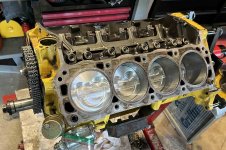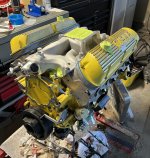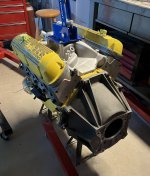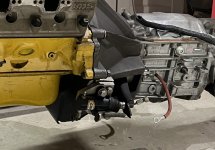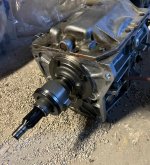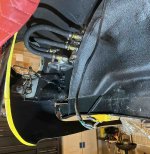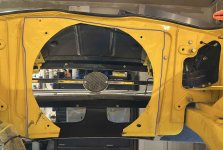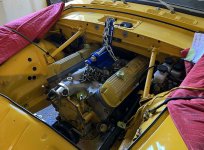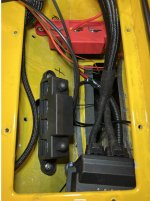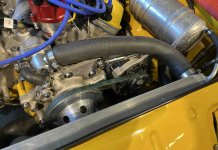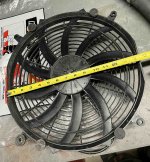Carbuilder
Gold forum user
- Messages
- 117
It is nice to have an extra bearing in case I need it. Some straightening required.It's nice to see the previous builder was meticulous when he built the engine 😀
It is nice to have an extra bearing in case I need it. Some straightening required.It's nice to see the previous builder was meticulous when he built the engine 😀
They were new heads, so don't see a reason for them to be machined. But you did get me thinking...maybe the thick head gasket was to allow for the valve/piston clearance? It does have a fair bit of valve lift (.563" exhaust). But I just removed all the pistons, so don't feel like putting one back in to check the clearance. The cam I have in mind has less lift but I will check the valve/piston clearance when I put it back together. I'm planning on a head gasket about .050 if the new pistons come out of the block the same .010" or so.I'd check the head thickness to see how far they've been milled. That's the only reason I can think of .80" thick head gaskets....
.080 ? LolI'd check the head thickness to see how far they've been milled. That's the only reason I can think of .80" thick head gaskets....
Well... .080 is what I meant!! I had to have a copper head gasket made for a Healey at .080, but that was because the previous owner/idiot put the head on the block w/o a gasket and left it that way for several years. The resulting corrosion necessitated a .080 gasket to get the valve geometry back to a point where everything would work..080 ? Lol
The electrolytic corrosion was on aluminum heads ? I have never heard of it before on an engine and the tensioning of the timing chain after decking makes sense. Those factors along with others made me go along with my engine being rebuilt be a friend who knows how to do it !Well... .080 is what I meant!! I had to have a copper head gasket made for a Healey at .080, but that was because the previous owner/idiot put the head on the block w/o a gasket and left it that way for several years. The resulting corrosion necessitated a .080 gasket to get the valve geometry back to a point where everything would work.
The only other reason I can think that .080 gaskets would be required is if the block was decked too far and the geometry to fit the intake manifold was impossible. I'd certainly suspect this if the outer part of the crown of the piston was above the deck of the block.
The Aston currently in the shop had the head go soft (electrolytic corrosion)... someone welded it up and warped the snot out of it and ended up taking near 1/8" of an inch of the surface (.125) I advised replacing the head as the valves did interfere with the pistons and there was doubt that the timing chains would properly be tensioned... As a fall back I suggested a solid copper gasket be made at .125"... I was overruled and the client instead de-stroked the engine and bored the liners to give a total displacement of 4.2 litres. It runs, and gave 300HP/300ft. lbs. of torque at 5000 RPM, but... the head is STILL soft and leaks coolant from the top of the head between the plugs. OOPS. it's going to have to come all the way apart and have a new head fitted. Just very happy I had nothing to do with the rebuild.
yes, probably in the block as well, but not as bad. Astons have alloy heads and blocks with drop in cast iron wet liners for the pistons... use the wrong anti-freeze, or just water and this will happen. I had a Jensen Healey 20 years ago and a Cosworth SCA (Formula Jr. race engine) and they both had the same problem. The new head for the Aston is $15K USD... plus shipping!The electrolytic corrosion was on aluminum heads ? I have never heard of it before on an engine and the tensioning of the timing chain after decking makes sense. Those factors along with others made me go along with my engine being rebuilt be a friend who knows how to do it !
I just installed The Summit 1799 cam. .456 lift and 204 deg duration at .050"
It seems very drivable. My only problem now is an annoying tappet tick. The are all new Summit hydraulic tappets so I need to investigate further.
Unfortunately, with the cast valve covers, I have to lower the engine to get the stupid covers off!
Caution about new tappet (lifters). There's plenty of on-line (U tube) comments about them. The manufacturers (?) are missing the fact that there is supposed to be a .002-.003 crown on the bottom (not flat) . A dial indicator run across them at a 90 degree X will reject the flaws and you should send them back. Then there's the cams no longer being "chilled" and requiring a high idle break-in. Collapsing lifters will chew up a fresh cam in no time. The bean counting new engineers need a wake up call.
There should be zero tappet noise. Are you sure you set them up correctly? With each cylinder at TDC, tighten rocker locknut to zero lash and then tighten 1/2 to one full turn. Interestingly, the Tiger shop manual states two full turns.I have read the comments. I thought a Summit cam with Summit lifters would work. We'll see. The tappets are not hammering. They are just noisier than I like.
I broke the cam in carefully so I think it is ok. I'll fix it, but it is a pia.
